MARKET OVERVIEW
The Global Marine Pump market is known to stand quite tall within the bigger maritime industry owing to its fuel supply functions across all requisite marine markets, such as for transport, offshore oil and gas exploration, and cargo handling. The demand for pump systems will grow as the industry requires extra reliability, efficiency, and durability in increasingly complicated environments such as the evolving maritime industry.
Marine pumps are meant to perform various essential tasks, including water transfer, fuel supply, and ballast management. They are structurally important because they assist in balancing with propulsion and structural integrity. As they will become sophisticated, the importance of pump systems that are reliable will become high. This requirement will be even greater for modern vessels because of the sophisticated environment they will operate since special attention will be focused on pumps that can endure high pressure and attacks from saltwater.
The transformative role of technology will be one of the most significant inhibitors to the future of the Global Marine Pump market. Gradually, such advances by clever, efficient pump technologies will be developed to facilitate operation and drastically reduce maintenance costs. Pumps will gradually include sensors and automatic operations-such that they can adapt to dynamically changing operating conditions. Such changes will lead to increased overall operational efficiency and, to some extent, safety since critical systems will still hold even though the conditions are extreme.
As concern for the environment becomes increasingly stronger, so too will the demand for an increase in the application of environment-friendly pumping solutions in the Global Marine Pump market. The sustainability and emissions-reduction initiatives are going to push few of the manufacturers to come up with modifications toward pumps that produce less energy consumption and, generally, lower the environmental footprint from marine operations. Expect more and more on-shore and offshore applications toward the green approach in pumping: energy-efficient motors, biodegradable materials, etc.
As far the regional perspective of the market defines, they will be important factors in determining the future of the market. Most regions must be interested in different rates of demand because of their maritime activities. Therefore, those regions that conduct oil and gas explorations, like the Middle East and south-east offshore, will demand high-capacity marine pumps. On the other hand, regions whose focus is mostly on commercial shipping will need high-performance pumps to handle cargo and manage fuel. These regional differences will affect market segmentation and eventually shape the pump designs and production profiles specific to the markets' needs.
Global Marine Pump market is estimated to reach $8428.4 Million by 2032; growing at a CAGR of 5.2% from 2025 to 2032.
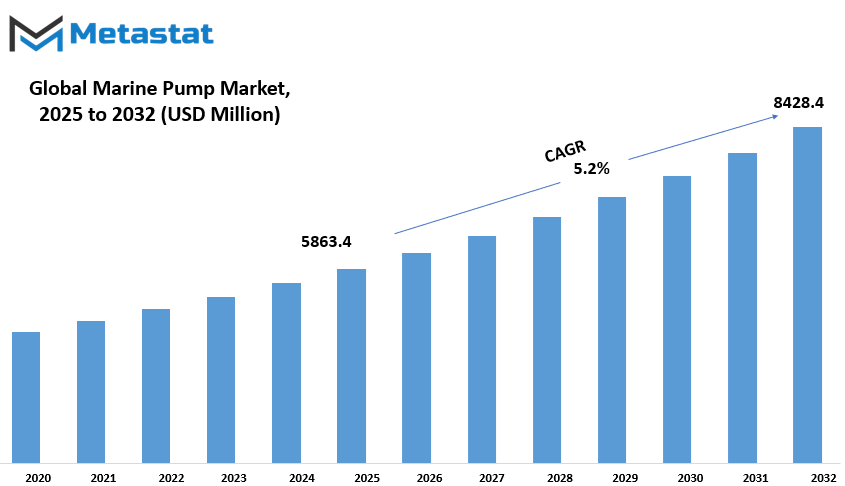
GROWTH FACTORS
The global marine pump market is ever-changing, influenced by many factors that drive growth and development. The demand for efficient and sustainable marine transport systems is a significant driver affecting this market. As international trade continues to increase, maritime shipping connects economies; therefore, the need for reliable, oil-efficient marine pumps has never been more urgent. All these pumps, having their own peculiarities, are designed to consume less fuel for environmentally sustainable practices with operational efficiency.
Apart from this, growing trade by the sea will also influence demand for advanced marine pump installations. The volume for shipping goods around the world has been steadily increasing; thus, in turn, modern-day pumps that can keep up with contemporary demands of shipping operations are going to be needed onboard vessels equipped with such pumps. Demand for high-performance pumps is consequently indirectly fueled by the growing shipping industry to safe and efficient transportation of goods.
Now, challenges do exist despite many advantages, which generally act as barriers to such businesses. Most of these involve the heavy operational and maintenance cost related to marine pumps. Since they are important for the smooth functioning of a ship, marine pumps are regularly maintained for long-term reliability. Maintenance and repairs associated with these pumps can also be huge and, thus, this imposes a burden on the finances of owners and operators of shipping companies.
Global regulation is yet another factor whose effects can be felt in the marine pump market. It has proved to be expensive and time-consuming to conform to the increasingly stringent environmental standards and regulations. There is also pressure to invent new techniques and approaches in marine pump manufacture, all while international society pushes for cleaner technologies, making the market more complex.
But this has not only limitations; it also has a lot of high potential growths. Continuous development in pump technology is one of the biggest opportunities. New technology is making pumps much more efficient in terms of energy consumption, thus reducing fuel usage and environmental impact. New materials, as well as better designs, are making longer-lasting, more reliable pumps, enabling companies to reduce operational costs. Growth in offshore oil and gas exploration is another key driver of demand for specialized marine pumps.
The deep offshore environment becomes subject to increasing exploration, thus enhancing its demand for pumps that cater specifically to offshore needs. Specialized pumps are the key in extracting and transporting oil and gas from offshore locations hence, they will provide market growth opportunities in the sector.
MARKET SEGMENTATION
By Type
Marine pumps are an inevitable part of the engine working in various marine sectors such as shipping, offshore oil and gas, and marine engineering. Within global marine pump markets, pumps belong to either Positive Displacement Pumps or Roto-Dynamic Pumps. These descriptors include what the pump actually is because the application is always for different kinds of specific marine operations.
Positive Displacement Pumps are widely utilized pumps in the marine sector. This pump acts by trapping a defined volume of fluid and forcing it through the discharge pipe. This pump is suitable for viscous fluids and options with solids; hence, these pumps become convenient for such maritime applications as oil transport. Its market size in the Global Marine Pump market is around $1883.5 million, representing its importance in marine operations, as they provide a constant flow of fluids, independent of pressure changes, hence making it reliable in various industry processes. Furthermore, they are very often used in applications that need precision and reliability like fuel or oil on board vessels.
On the contrary, Roto-Dynamic Pumps function on the principle of fluid flow by regulating an impeller rotation. Most of these pumps are more favored in high rates of flow. They work well under the provision of less viscous liquids. Unlike the operation of Positive Displacement Pumps, Roto-Dynamic Pumps do not store any quantity of liquid within them but rather regulate a constant flow matching their speed of rotation, thus making them more suitable for continuous and steady processes.
These pumps are widely efficient in use and can be found used in many general application examples in marine kinds of stuff such as cooling systems or ballast water treatment. They will definitely not be that great in pumping thicker or more viscous liquids, but with an outstanding performance in huge volumes of water or other fluids distributed across marine vessels, they qualify as really good performance for their relative geometries.
These pumps are both Positive Displacement and Roto-Dynamic, and their importance can be bundled up in the safe and efficient operations of marine systems. While Positive Displacement Pumps can give a lot in handling very dense and complex fluids, Roto-Dynamic Pumps will allow benefits towards efficiency in flow and also leave options for applications in more general marine applications.
Demand for both types of pumps will continue to grow, propelled by increased global demand for maritime trade, offshore exploration, and improved environmental standards in the marine industry. And each output has its unique assets, and the selection of each will depend on the specific consideration of the marine operation in question.
By Application
The Global Marine pump market is a leading industry for various activities, including transportation, defense, and commercial trade. Marine pumps are very important elements within ships regarding the functioning of water circulation, oil movement, and other critical activities that significantly affect the operational capacity of the vessel. Different categories of ships require pumps for various applications within this market. Three heavy industries have been segregated under this market on the basis of the demand for marine pumps: Civil Ships, Military Ships, and Commercial Ships.
Civil ships include passenger vessels, cruising liners, and cargo ships, some of the most substantial consumers of marine pumps. Pumps are generally used for wayside facilities to keep the water for cooling systems, ballast, and drainage in and out of the ship, maintaining the stability and operability of the vessel. Growth in global trade and tourist activities in the world is likely to have an impact on the pumping industry in civil ships, as these pumps serve to improve the state of balance within the ship and prevent overflow into the insides of the technological systems. Their safety and comfort for the passengers and crew members are also important.
Military vessels and warships also depend on marine pumps. Pumps in military ships will be serving purposes of maintaining the integrity of systems in the vessel where water and fuel management is concerned. These pumps are highly resistant to any harsh conditions and provide uninterrupted services even during uncompromising high pressures during combat or severe weather conditions. Increasing worldwide defense budgets will likely increase military demand for advanced marine pumps. Various operations can be controlled with the pumps fitted in military ships-from cooling down engines to handling water in emergency situations, ensuring the proper operational readiness of the ship.
Yet another main part in marine pump market includes commercial ships for example freight and container carriers dependent on pumps for loading and unloading cargo, fuel systems, and ballast and waste management. As the world trade undergoes continuous development, commercial shipping will keep on demanding marine pumps. These ships will rely on pumps to keep up productivity, reduce delays, and efficiency for transporting global goods.
The Global Marine Pump Market shall continue its growing trajectory with an increasing requirement for efficient and reliable pumps in various industries. The development of marine technologies, combined with the fact that there is a demand for increasing sustainability and operational efficiency, is likely to increase the design and adoption of such new pumps for civil, military, and commercial vessels.
|
Forecast Period |
2025-2032 |
|
Market Size in 2025 |
$5863.4 million |
|
Market Size by 2032 |
$8428.4 Million |
|
Growth Rate from 2025 to 2032 |
5.2% |
|
Base Year |
2024 |
|
Regions Covered |
North America, Europe, Asia-Pacific, South America, Middle East & Africa |
.
REGIONAL ANALYSIS
The marine pump market is being segmented with respect to various geographical regions that are North America, Europe, Asia-Pacific, South America and Middle East & Africa. North America will constitute three major countries primarily, which are the United States, Canada, and Mexico. The UK covers the rest of Europe, Germany, France, Italy, and other European countries not mentioned under these names. Asia-Pacific contains a large number of countries, such as India, China, Japan, and South Korea plus others without specific mention. South America consists of Brazil, Argentina, and other unnamed countries around the region. Finally, countries into the Middle-East & Africa will comprise Gulf Cooperation Council countries, Egypt, and South African countries, and all other countries that fall in this region but not in any of the above categories.
Having this classification would go a long way in understanding the performance of the marine pump market across different geographies and bringing to light regional trends and development. This helps the stakeholders understand the sort of unique demands and growth opportunities available in each region. The specific targeting would enable organizations dealing in the marine pump market to pitch their strategies and products according to the special needs of every area. So the geographical segmentation helps to define the region where investments, research, and innovations are likely to trickle in next so that they can formulate their strategies based on market growth around that area.
In general, the division of the global marine pump market into these particular regions helps to shed light on the regional dynamics affecting both supply and demand. Once all trends and changes become clear to the eyes of potential interested parties to the marine pump market, trends can be traced, facilitating businesses and various stakeholders in their decision-making. Whereas this segmentation serves as a basic base in considering the growth prospects and market obstacles around the globe, it becomes a tool for business assessment.
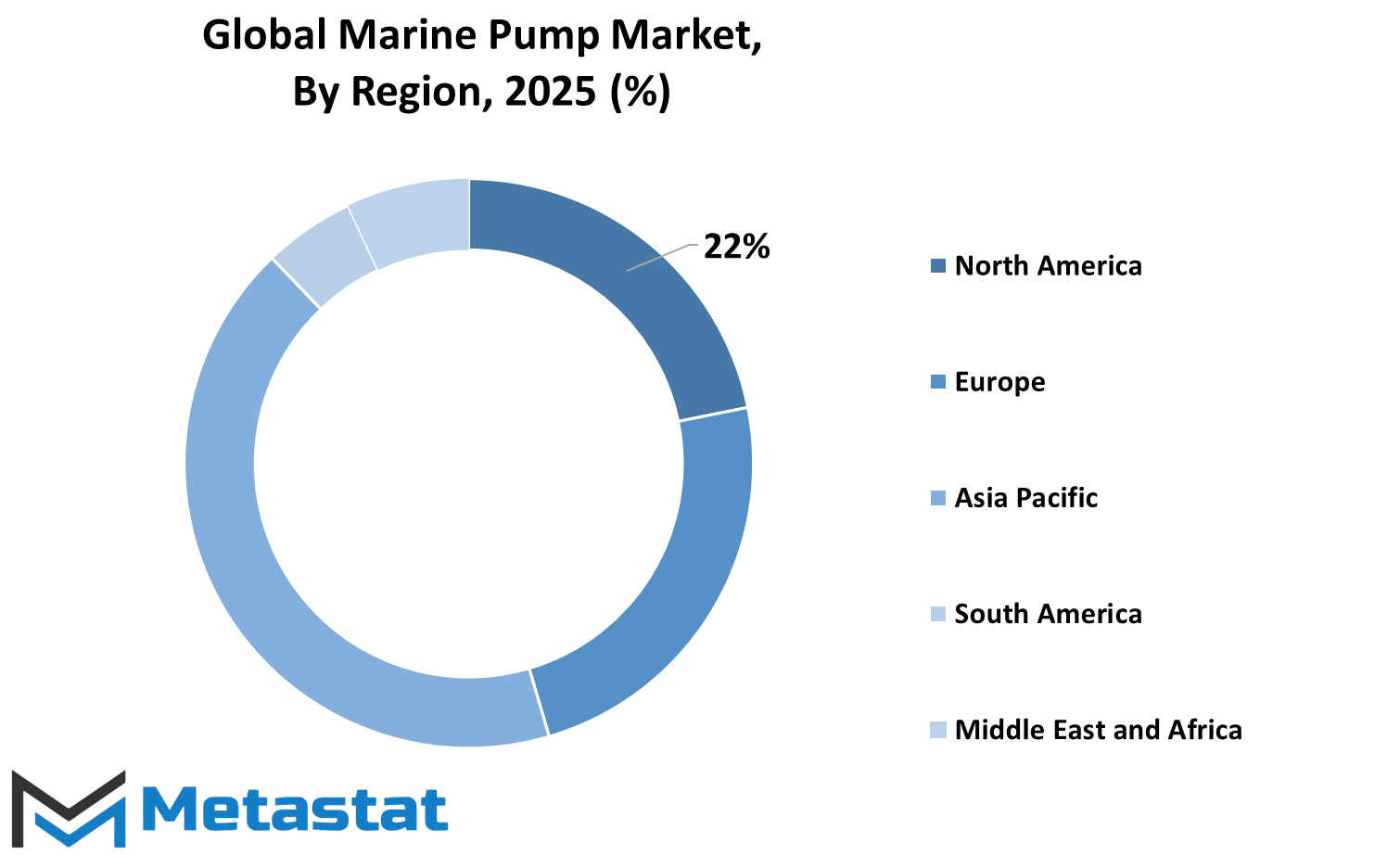
COMPETITIVE PLAYERS
Major companies such as Allweiler (Circor) and Hamworthy Pumps, Buffalo Pump (AMPCO), and many others provide different types of marine pumps and influence effectively the global marine pump market. Including such companies as Carver Pump Company, Grundfos Holding A/S, and Flowserve Corporation, these companies contribute to the designing, manufacturing, and distribution of marine pumps for various segments of the market.
In the race for marine pumps, KSB SE & Co. KGaA and Sulzer Ltd are also no small fry, as they provide a wide variety of products that are designed for the durability and efficiency they offer in marine environments. Support for industry development comes from firms such as EBARA Pumps Europe S.p.A. and Rotech Pumps & Systems Inc. with innovative pumping solutions that cater to commercial and industrial needs.
ITT Goulds Pumps and SILI PUMP would be bringing their know-how with regard to high-performance pumps to the sector under discussion, particularly to the rigorous requirements for reliability and efficiency that an environment such as marine needs. Jiangsu Zhenhua Haike Equipment Technology Co., Ltd., with its pumps that are used in different industries on the sea, adds to the competition in the market.
It also purports to be one other stakeholder in the market besides Xylem Inc. and Wastecorp Pumps in providing advanced technology and pumps that suit the increasing demand in the marine sector. The remaining key players under such names include APEX PUMPS INDUSTRIES and Pentair plc, offering robust and energy-efficient solutions tailored to marine applications. Completing the long list of top players are the likes of Settima Meccanica Srl and MARCO Sp.A.
These companies and their contributions are indicative of the diversities inherent in the marine pump market, which is innovating and technologically evolving to create demand for quality products. Such companies will continue to keep pace with the emerging trends and developments in the marine industry, responding to the needs of all key players when it comes to effective pumping solutions, ensuring smooth vessel and offshore facility operation. As efficiency, environmental friendliness, and cost-effectiveness grow increasingly important, so will the roles of these players in the future of the marine pump market.
Marine Pump Market Key Segments:
By Type
- Positive Displacement Pump
- Roto-Dynamic Pump
By Application
- Civil Ship
- Military Ship
- Commercial Ship
Key Global Marine Pump Industry Players
- Allweiler (Circor)
- Hamworthy Pumps
- Buffalo Pump (AMPCO)
- Carver Pump Company
- Grundfos Holding A/S
- Flowserve Corporation
- KSB SE & Co. KGaA
- Sulzer Ltd
- EBARA Pumps Europe S.p.A.
- Rotech Pumps & Systems Inc.
- ITT Goulds Pumps
- SILI PUMP
- Jiangsu Zhenhua Haike Equipment Technology Co., Ltd.
- Xylem Inc.
- Wastecorp Pumps
- Apex Pumps Industries
- Pentair plc
- Settima Meccanica Srl
- MARCO s.p.a.
WHAT REPORT PROVIDES
- Full in-depth analysis of the parent Industry
- Important changes in market and its dynamics
- Segmentation details of the market
- Former, on-going, and projected market analysis in terms of volume and value
- Assessment of niche industry developments
- Market share analysis
- Key strategies of major players
- Emerging segments and regional growth potential



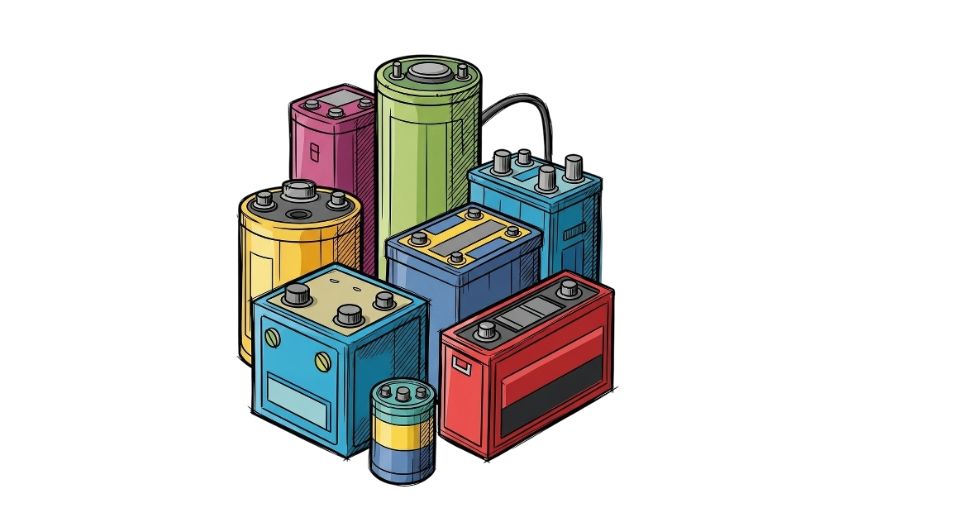
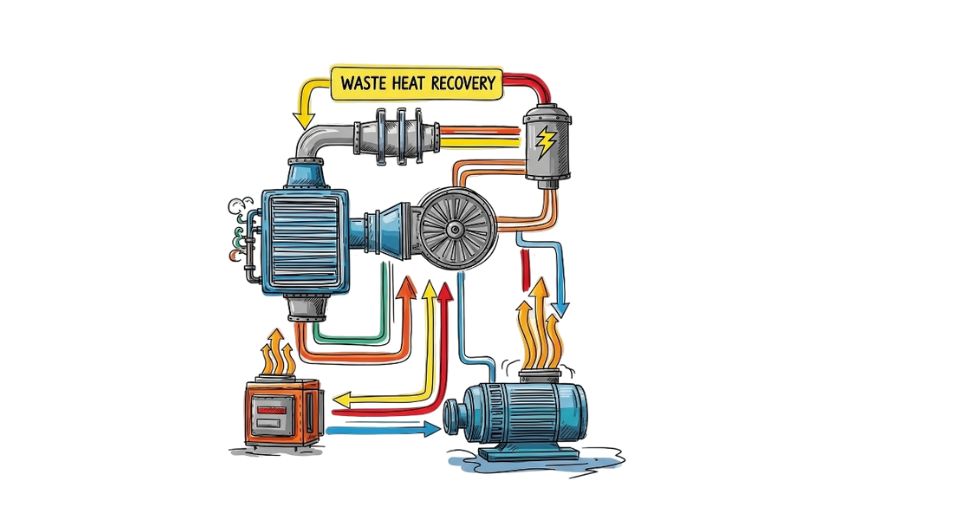

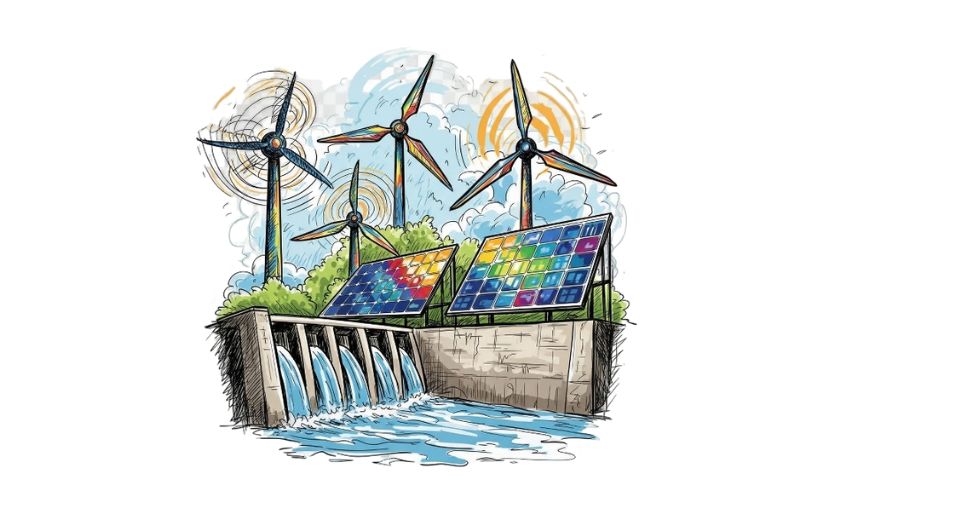

 US: +1 3023308252
US: +1 3023308252






